#Aspect Impact Analysis
Explore tagged Tumblr posts
Text
♻️ Mastering the PDCA Cycle in ISO 14001 – A Practical Guide to Environmental Excellence
Environmental management isn’t just about compliance—it’s about commitment. And the best way to embed this commitment into everyday operations? The PDCA cycle. Whether you’re just starting your ISO 14001 journey or enhancing your existing EMS, this blog breaks down the PDCA cycle with real-life examples, legal compliance tips, and a clear view of responsibilities. 🧩 What Is PDCA in ISO…

View On WordPress
#AD ISO Insights#Aspect Impact Analysis#business#Continual Improvement#Corrective Action#EMS#environment#Environmental Compliance#Environmental Management System#Environmental Objectives#Internal Audit#ISO 14001#ISO 14001 Clauses#ISO 14001 Implementation#ISO Blog#ISO Certification#ISO Standards#leadership#Legal Requirements ISO 14001#PDCA Cycle#PDCA Examples#Risk Assessment#sustainability#technology
0 notes
Text
There is a super annoying review of Lady and the Tramp on here trying to say that the film isn't about classism. While half-baked yes, I think it is very clear, ESPECIALLY with the historical context of romance films that came out at the same time, that it can't be seemingly pushed to the side simply because it is used as "dressing" for a film otherwise about dogs falling in love.
#felt very back-handed as a review#idk maybe I am sentimental because I have a bit of a personal connection to the film#but I do consider myself cognizant of film history and historical trends in the united states and I think the film picks up on these#whether they be intentional or a result of the way the theme of romance was handled back then#so many 40s and 50s movies are very pre-occupied with 'forbidden love' and the impact of marrying into your class or not#it drives such a hard stone that you get cases like in philadelphia story where the female lead#goes for cary grant despite (arguably) showing more of a connection to jimmy stewart because cary grant's class#would be the least controversial option#in a film going into the new hollywood era onwards I think in the face of a similar plot they would do the latter#idk I think a LOT more behind the scenes stuff went into play to make the script what it is#which explains the romance and themes being loose and somewhat rushed#but I don't see the classism aspect as ignorable as this reviewer put it#this is going to sound rich coming from me avid cartoon over-analyzer#but it feels like people settle for too high expectations when they make reviews#like idk are you expecting kubrick level work or something? chill out and lend precedence to what is already there#or whatever people are allowed to not like some films#I just think some ppl don't really know what they are talking about oops#lady and the tramp#lady and the tramp analysis#midnight matinee#squack
7 notes
·
View notes
Text
I have a horrible little sci-fi guy with gifted kid burnout and the expected self-sacrificing streak to go with it, all buried under actually giving into their worst instincts and hurting those around them for the sake of hurting themself. I have their equally horrible ex, their overcompetant boss, and a doctor with no medical training. I've put them all into situations but do i have a proper plot? nooooo
#warfts jae#dumb shit i do#we're all reaching for the sun#I'm so annoyed by it too. the plot for warfts just really came together neatly but this story is fighting me#I think one of the issues is I really don't have a clear idea of the themes. and I intrinsically write based around themes like that#I mean i always joke about it but truly#warfts is my 20k essay against war and made a friend go 'wow you actually...have strong feelings about things' which#I've never totally been sure how to take. did you think I didn't have politics???#Sorry totally a ramble now:#My special interest is how the failure of global systems led to the vietnam war. And how the vietnam war led not to an end#to those kinds of conflicts. but rather a shift in how they were DEPICTED#go read any analysis on how the gulf war was televised as opposed to vietnam#incredibly interesting#I have a book of essays from vietnamese and american historians considering different aspects of how the war impacted the world#Jae's story is not focused on the impact of war but they are a vestige of the military in many ways#I think that decolonization would be a very interesting theme for this story but I'm not sure how to go about that properly#I think I need to go read more history books#is this the only way I know to write scifi
7 notes
·
View notes
Note
I saw you mentioned kujou sara on your hope player post, would you mind elaborating on your reasoning behind her being a hope player? Im not judging i promise I’m just a curious Sara fan lol
Of course! I'm more than happy to elaborate~
Kujou Sara: The Heir of Hope
Heir:
One who is influenced by their aspect
Alternatively, one who inherits their aspect or one who becomes their aspect
Hope:
Abstract: Conviction, Imagination, Fantasy, Delusion, Actual Hope
Literal: Light, Wings, Feathers, Religion
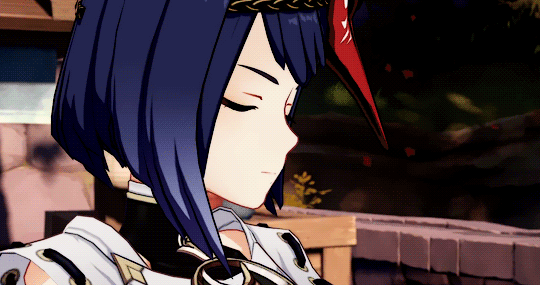
Hope is the aspect of ideals and conviction; driven by what they think is right and deliver justice to what they consider is wrong:

Kujou Sara is no different. The Lady Tengu has earned the title 'Devotee of the Divine' for her loyalty to her Archon Ei. She is known by many people of this characteristic of hers.


She had even abandoned her ties with her fellow youkai in order to serve the mortals of the shougun's land, as said by Dainslief


There's a comment Kokomi makes on her faithfulness to the Shogun, commending how she can uphold it no matter what her god demands of their people, and perfectly summarizes her classpect:

The context of this opinion comes during the middle of a civil war between the rebels lead by Kokomi and the Shogun's forces led by Kujou Sara. The battle has arisen from a decree in which all citizens of Inazuma must give up their visions, either voluntarily or by force.
Most, if not all, were discontent with the Vision Hunt Decree and opposed it, unlike the Tengu General who in fact upheld it. She believed that the manifestation of her ambitions was not hers, but Ei's and would gladly return it to her if asked of her.

Sara held the belief that the Shogun had the right to withdraw everyone of their visions, including hers, and so she became the head of the Vision Hunt Decree.
So how can a woman who isn't a mortal come to adore the Shogun so much?

According to Sara's vision story, the Tengu fell from a height that should've killed her. Yet the next morning, she was found relatively unscathed. The only thing that could explain the anomaly was the glowing vision in her hand.
There is a common misconception that the Archons are the ones who hand out visions, and that prenotion is the foundation of Sara's beliefs.
She believed to be favored by the Electro Archon herself and was rewarded a vision and thus saving her life. And for saving her life, Kujou Sara devotes it to the Shogun.
Which segways nicely into her class: The Heir
Heirs, like Witches, are a part of the Magician class, but instead of influencing their aspect as they like, Heirs are influenced by it.
They're natural born leaders, often being the driving force of their teams that propel them towards their goals.
Egbert is one such Heir. The first character you meet in the webcomic and the leader of his friends' SBURB session. This Breath-bound was able to direct the rest of the Beta kids on what to do during the early part of the game. He was also the first to ascend to godtier, a massive step in SBURB's progression.
The most important instance though, happens after the events of Game Over. John, under Terezi's instruction, is sent to F1X the timeline with his retocon powers so it doesn't lead to the utter oblivion of everyone and their session.
In other words, Egbert can influence the direction of the timeline.

However, when an Heir's aspect comes to them naturally, they mustn't let it consume them.
Heir of Doom Mituna Captor once was a powerful psiioniic that had the ability to foretell disasters, which could've been used to guide his SGRUB team away from trouble. Despite its usefulness though, no one would belive him, causing things to take a turn for the worst for the goldblood:

With no one taking into consideration his warnings, Mituna was left to himself before his mind is consumed by his visions: Burning himself out to protect his teammates from an unknown threat, becoming doomed. That final act of heroism rendered him powerless and brain-damaged.
Then there's Heir of Void Equius Zahaak. He had very little in terms of screen time. Void is the aspect of isolation and the b100 b100d and usually kept to himself in the start of Hivebent. He has strength that surpasses most of the beta trolls to the point where he can bruise anyone with the gentlest of touches from him, making him unable to even touch another troll.
Though he was able to overcome the loneliness with his moirail Nepeta, Equius wasn't able to save himself from succumbing to irrelevance and obscurity; Being killed by Gamzee and his identity being overwritten by AR, effectively erasing Equius from the story


To tie this all in with Kujou Sara... yes, she is described as a charismatic and natural-born leader as well as often being what inspires her troops to keep on fighting, a symbol of hope. Just as an Archon's power is proportional to their people's belief in them, Sara's belief in hers empowers her.



Sara's sense of right and wrong matches those of the Shogun, inheriting her morals and making them her own. It feels almost as if she embodies her will.
She is willing to fight and take down those who don't obey the Shogun, even going as far to wage war with Watatsumi Island. But Sara would do anything for her god if it meant that she was doing the right thing.


Like before, it's admirable that her loyalty knows no bounds, but she's is so consumed in the shogun that it harms the people that she is supposed to protect. Gorou, a general on the other side of the war, and Kazuha both comment on this characteristic of hers. Her devotion to the Electro Archon is the driving factor as to why she went along with the Vision Hunt Decree despite it being unpopular to Inazuma's citizens. Rather than listenting to the Shogun to demonstrate her allegiance to Inazuma, she should've listened to its people as the Vision Hunt Decree has caused some to loose their drive to live.



Not only is this loyalty detrimental to others, but also to herself as for most her life she put the shogun before her own personal desires:

After the Hunt, however, Sara starts to break out of the mindset she has and starts to think for herself. Her first act of her individuality is to apologize to those she has hurt during its reign.


As Heir of Hope, Kujou Sara has already shown to be a great commander for her army, so much so that I would consider her to be Inazuma's leader if it weren't for Ei's puppet.
An Heir of Hope is powered by belief. If this lady Tengu were to place more of her devotion into the people she swore to protect, then perhaps she could ascend from being a major figure head of the Kujou clan to one that would reflect Inazuma’s image.

#ask#homestuck#classpect#classpect analysis#godtiers#genshin#genshin impact#genshin kujou sara#kujou sara#hope#hope aspect#heir#heir class#heir of hope
28 notes
·
View notes
Text
Peeta Mellark is an integral member of the four D12 victors. He is literally the sunset on the reaping! How is this not clear? I’ve never wanted to report people for bad literary analysis more and I’m only half joking. It has forced me to commit a cardinal sin: analyze in anger!
1. Him being chosen by absolute accident is the point. Not only does he represent every single other tribute who simply gets chosen because they live in a messed up country but he represents how even with some odds being in your favor (older siblings, merchant family, being white, being popular, etc.) you are still very likely to be victimized by the oppressive structure of Panem.
2. When Haymitch says, “But she was smarter than me, or luckier” - the luck is all the people around Katniss who created the circumstances for her to lead a successful revolution (her father teaching her to hunt, the arena having woods, Rue healing her with leaves, Thresh not killing her, Haymitch consistently giving her support, her mother teaching her aspects of medicine, on and on and on) and Peeta is the number one, most important part of her luck in the first book. She has someone in the games actively putting her life before his… are you kidding? There is legitimately no better luck than that.
3. Even if we take Katniss out of it, Peeta is so impactful as a victor because most of his scenes would not be cut/doctored. What’s there to edit out? Instead, the viewers get a full view of him loving a girl so selflessly, using trickery and strategy instead of violence, keeping himself alive through art, joking on literal death’s door, and sharing so much of himself with the audience it becomes harder for them not to see him as a real human boy. How rare do you think that is for the games? Haymitch and LGB are caricatures of themselves in the games, playing roles that flatten them down. Even Katniss becomes one dimensional on screen without Peeta (and Rue, of course). It is also heavily implied that he does not kill anyone during the games (in a straightforward way) and even if you count Cato or the girl from 8 or even foxface, it’s never him hunting them or seeking out a kill - again how rare do you think that is to see on screen for Games viewers?
4. I didn’t think this needed to be said but: Katniss dies without Peeta in the first games. a) she goes for the bow and dies in the bloodbath; b) she is hunted and killed by Careers; c) she is killed by game makers because there’s no love story angle to keep them from just burning her entirely; d) she dies from tracker jacker stings or Cato because Peeta doesn’t defend her or tell her to run… I could go on…
5. But even if she does win and wins alone - the victory means as much (I would argue less than) any other rebellious victor winning, certainly less than Haymitch’s win. The biggest rebellion for their games is that two of them win! This is legit the only thing that distinguishes them from any other sympathetic, kind child who would have won the games. Like if Haymitch or Finnick or Wiress winning isn’t jarring enough for the Games to end… why do you think Katniss killing Peeta and winning solo would be? It would not.
6. And finally, I cannot stress this enough: There is no peaceful end to the rebellion or the trilogy without Peeta. “Peeta’s a whiz with fires” (HG) for a reason! Collins, over and over, shows us how fire can get out of control and destroy even those who are innocent and who you love (Gale, Beete, Peeta’s family, Haymitch’s family). If everyone really burns, there’s no one to clean the ashes. The reason not everyone burns is because of people like Peeta who can coax the flames in a way that is nurturing and consistent. I mean…. “Peeta fashioned some kind of incubator” is such an obvious detail. Those goslings don’t hatch without Peeta, life does not go on in peace and joy without Peeta.
It is no coincidence that when Maysilee says Lenore Dove got the “jump on us all” (in being a rebel), she is referring to LD using orange paint to make protest art!
We must stop pushing Peeta Mellark out of the narrative! He is literally the sunset on the reaping!
#everlark#the hunger games#thg#art#hunger games#katniss everdeen#peeta mellark#haymitch abernathy#thg sotr#sotr spoilers#sunrise on the reaping#sheisoverherereading#thg analysis#sotr
9K notes
·
View notes
Text
IMPACT OF 7 PLANETS ASPECT ON KETU DURING THEIR TRANSIT
QUESTION ASKED : On 30th March 2025 all the 7 planets shall aspect Ketu. What is going to happen ?
MY VIEWS : There is no direct simple answer to the question and so the reader needs to read the whole explanation and then understand the meaning of the question step by step.
My answer is as per KP Vedic astrology parameters.
It is just difficult to say about the potential effect of 7 planets aspecting Ketu in one sign in a horoscope, in general answer also.
It is because as per KP Vedic astrology padhatti / system one study the effect of a house by learning about the significances of the cuspal lord of that house.
The transit planet has the last role to play in activation of an event and it by itself do not have any power to give an event if it is not promised in a horoscope and signified by the ruling mahadasha on the period of time.
The transit planet merely acts like a ON OFF button to activate an event promised by horoscope and mahadasha period.
One thing that readers should note that an event gets activated as per horoscope in the life of an individual is ONLY WHEN IT PROMISED IN HIS HOROSCOPE.
The timing of the delivery of an event is determined by the mahadasha period. If the mahadasha is not running the agenda of an event that is promised in the horoscope, it will not happen during its ruling mahadasha period.
Here when all the 7 planets are aspecting Ketu in their transit then they will all act as an ON OFF button for activation of the events signified by ketu and is also promised in horoscope as well as the current ruling mahadasha of that individual.
I understand that things are getting complicated but take a deep breath and read it once again, you will definitely understand ha ha ha ha . . .
If ketu in a particular horoscope is signifying some events but they are not promised in the horoscope level and so during the aspect of the planets in their transit will have no impact. There could be some environment change but event will not happen.
AND this will vary from person to person as per their horoscope and so there can not be a general common prediction for all for the 7 planets aspecting ketu in their transit.
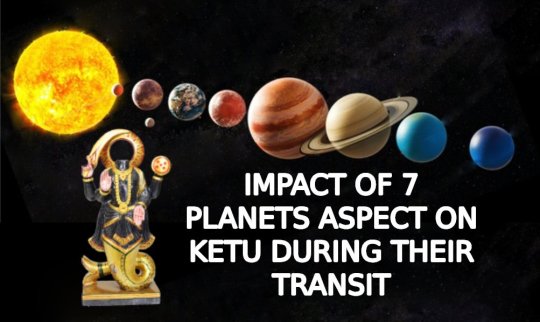
#aspect impact astrology#vedic astrologer#horoscope posts#horoscope analysis#horoscopes#horoscope readings#horoscope#astrologer#astrology#vedic astrology#vedicastrology#daily horoscope#daily astrology#remedies#indian jyotish#vedic jyotish
1 note
·
View note
Text
Okay... So I'm in a way right now with the red tide and hormones..... But I did want to say some things about SINNERS while I have a little bit of mental energy.
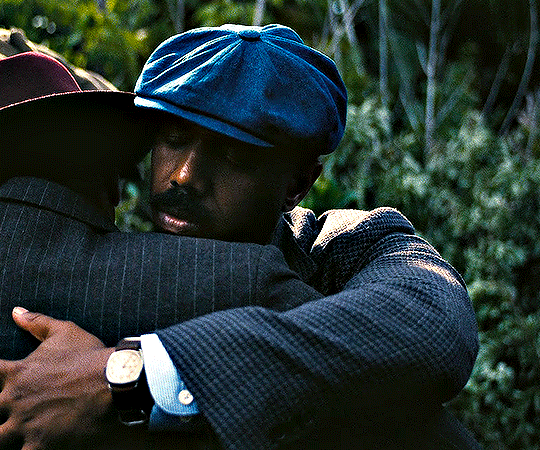
Stack and Smoke are two sides of the same coin, yin and yang, red and blue, Italian and Irish gang clothing style... etc.
Some people are getting carried away with analysis and it's giving more projection of what you want it to be vs. what is.... Coogler himself has cited great fun tropey horror films and pop culture touchstones like Salem's Lot (the book not the movie) and Puss in Boots: The Last Wish (which I love that that's a reference) he has said his most important takeaway is "ownership of art."
The act structure that gave us that classic "caper" set-up of all kinds of characters listening to the plan and then going "you sonavabitch, I'm in." for the juke joint was my favorite part of this TBH.
It is NOT a Christian "Come to Jesus" movie and I LOVE that about it. In fact, it's the opposite.
It's a "be true to self and your gifts in the face of any god or devil", movie.
BOTH women love interests (white presenting and full-figured and unambiguously Black ,--back to that yin and yang of the twins) were beloved by a twin, both fit the elemental nature of said twin, and both had to traverse death to be with their love.
As an aside.... loved hearing a southern accent from our Asian cousins, seeing the "not my problem" energy from the Choctaw hunters, and the reminder that there was actual ancestral cultural community before "whiteness" for white people too, and why many no longer have it...
LOVED LOVED LOVED the cultural details in the character work, setting, energy, etc.... ESPECIALLY Delroy Lindo's vocal cadence.
I loved what Coogler chose to NOT show to make the energy more impactful and palpable in both sensuality and scares.
I'll be the weirdo who prefers the pure blues vs. the remix but I LOVED seeing all the ancestors and descendents come and vibe with the music...I used to have recurring dreams of a multicultural ancestral world jam session, so "that scene" hit me hard.
Remmick just follows in the tradition of Coogler villains being compelling af, but ultimately WRONG because of an essential flaw in their logic (i.e. Killmonger's misogynoir and colonizing techniques and funnily enough Remmick's colonizing techniques, klan and black using vampire telepathy for a faux community peace)
I have seen no one else mention this, but I chuckled at Saul "List of Demands" Williams playing the preacher, aka Sammie's dad
the vampire nerd part of me absolutely rejoiced at all the "traditional" vampire warding aspects, ESPECIALLY the silver, something that is often wrongly asserted as being just for werewolves
loved how filthy and raunchy the language was when it came to desire... because that's real (and I hate purity culture which is very much now tied to the alt-right white Christo-fascist pipeline right now) AND centering women's pleasure and, in many cases audacious initiative. (ahem, I see you Ryan and I see how Zinzi's in the current state she's in, congrats!! *cough* this is the healthiest type of straight man sexual energy BTW)
BE WARY of the takes out there that are overly-projecting. It's neither religious nor hotepy. It's a Southern Gothic fable/folktale about a musician with a gift surviving a magical night....
YES it's full of ancestral energy, but ultimately the central message is about being true to self when it comes to ancestral gifts and community

#again#I'll add more later... but energy levels are low and I've been busy#sinners#meta#sinners 2025#smoke and stack#sammie#michael b jordan#ryan coogler#wunmi mosaku#miles caton#hailee steinfeld#jayme lawson#delroy lindo#li jun li#ps remmick totally ate that baby
1K notes
·
View notes
Text
Drawdown in Forex Trading with FTG
The blog titled "Drawdown in Forex Trading – Understanding and Managing Losses" delves into the concept of drawdown in forex trading, which refers to the decline in a trading account's equity from its peak due to a series of losing trades. The guide emphasizes the importance of effectively managing drawdowns to preserve capital, maintain confidence, and avoid impulsive decisions during challenging market phases. The blog explains the different types of drawdowns, including equity drawdown and maximum drawdown, and provides a simple formula for calculating drawdown percentages. It discusses common causes of drawdowns in forex trading, such as market volatility, unsuitable strategies, overleveraging, poor risk management, and external factors. The psychological impact of drawdowns on traders is highlighted, emphasizing the emotional toll they can take, leading to self-doubt and anxiety. The long-term effects of drawdowns on trading performance are explored, including capital erosion and missed opportunities. Strategies for managing drawdowns are extensively covered, including risk management techniques such as proper position sizing and setting stop-loss orders. Diversification and asset allocation, utilizing trailing stops, revisiting and adjusting trading strategies, and the importance of analyzing historical data are also discussed. The blog emphasizes the psychological aspects of dealing with drawdowns, including maintaining discipline, overcoming fear and greed, and the importance of keeping a trading journal for self-reflection and growth. The conclusion underscores that drawdowns are a natural part of forex trading and can be opportunities for growth rather than failures. It encourages continuous learning, adaptation, and using the support and resources provided by Funded Traders Global to navigate the challenges and successes of forex trading.
#Calculating the Drawdown Percentage#Common Causes of Drawdowns in Forex Trading#Drawdowns in Forex Trading#Continuous Learning#Definition and Explanation of Drawdown#Definition of Drawdown in Forex Trading#Diversification and Asset Allocation#Drawdown in Forex Trading - Understanding and Managing Losses#Evaluating Historical Drawdown Data#Forex Traders#Funded Traders Global#Identifying and Monitoring Drawdown Patterns#Impact of Drawdown on Trading Accounts#Importance of Keeping a Trading Journal#Importance of Managing Drawdowns#Maintaining Discipline and Emotional Control#Mitigating Drawdowns Through Analysis#Overcoming Fear and Greed#Proper Position Sizing#Psychological Aspects of Dealing with Drawdown#Revisiting Trading Strategies and Adjusting as Necessary#Risk Management Techniques#self-reflection#Strategies to Manage Drawdowns#The Long-Term Impact on Trading#The Psychological Effect of Drawdown on Traders#Types of Drawdowns: Equity Drawdown and Max Drawdown#Understanding Drawdown#Using Technical Indicators for Drawdown Prediction#Utilizing Trailing Stops
0 notes
Text

I feel that one of the most overlooked aspects of studying the French Revolution is that, in 18th-century France, most people did not speak French. Yes, you read that correctly.
On 26 Prairial, Year II (14 June 1794), Abbé Henri Grégoire (1) stood before the Convention and delivered a report called The Report on the Necessity and Means of Annihilating Dialects and Universalising the Use of the French Language(2). This report, the culmination of a survey initiated four years earlier, sought to assess the state of languages in France. In 1790, Grégoire sent a 43-question survey to 49 informants across the departments, asking questions like: "Is the use of the French language universal in your area?" "Are one or more dialects spoken here?" and "What would be the religious and political impact of completely eradicating this dialect?"
The results were staggering. According to Grégoire's report:
“One can state without exaggeration that at least six million French people, especially in rural areas, do not know the national language; an equal number are more or less incapable of holding a sustained conversation; and, in the final analysis, those who speak it purely do not exceed three million; likely, even fewer write it correctly.” (3)
Considering that France’s population at the time was around 27 million, Grégoire’s assertion that 12 million people could barely hold a conversation in French is astonishing. This effectively meant that about 40% of the population couldn't communicate with the remaining 60%.
Now, it’s worth noting that Grégoire’s survey was heavily biased. His 49 informants (4) were educated men—clergy, lawyers, and doctors—likely sympathetic to his political views. Plus, the survey barely covered regions where dialects were close to standard French (the langue d’oïl areas) and focused heavily on the south and peripheral areas like Brittany, Flanders, and Alsace, where linguistic diversity was high.
Still, even if the numbers were inflated, the takeaway stands: a massive portion of France did not speak Standard French. “But surely,” you might ask, “they could understand each other somewhat, right? How different could those dialects really be?” Well, let’s put it this way: if Barère and Robespierre went to lunch and spoke in their regional dialects—Gascon and Picard, respectively—it wouldn’t be much of a conversation.
The linguistic make-up of France in 1790
The notion that barely anyone spoke French wasn’t new in the 1790s. The Ancien Régime had wrestled with it for centuries. The Ordinance of Villers-Cotterêts, issued in 1539, mandated the use of French in legal proceedings, banning Latin and various dialects. In the 17th and 18th centuries, numerous royal edicts enforced French in newly conquered provinces. The founding of the Académie Française in 1634 furthered this control, as the Académie aimed to standardise French, cementing its status as the kingdom's official language.
Despite these efforts, Grégoire tells us that 40% of the population could barely speak a word of French. So, if they didn’t speak French, what did they speak? Let’s take a look.
In 1790, the old provinces of the Ancien Régime were disbanded, and 83 departments named after mountains and rivers took their place. These 83 departments provide a good illustration of the incredibly diverse linguistic make-up of France.


Langue d’oïl dialects dominated the north and centre, spoken in 44 out of the 83 departments (53%). These included Picard, Norman, Champenois, Burgundian, and others—dialects sharing roots in Old French. In the south, however, the Occitan language group took over, with dialects like Languedocien, Provençal, Gascon, Limousin, and Auvergnat, making up 28 departments (34%).
Beyond these main groups, three departments in Brittany spoke Breton, a Celtic language (4%), while Alsatian and German dialects were prevalent along the eastern border (another 4%). Basque was spoken in Basses-Pyrénées, Catalan in Pyrénées-Orientales, and Corsican in the Corse department.
From a government’s perspective, this was a bit of a nightmare.
Why is linguistic diversity a governmental nightmare?
In one word: communication��or the lack of it. Try running a country when half of it doesn’t know what you’re saying.
Now, in more academic terms...
Standardising a language usually serves two main purposes: functional efficiency and national identity. Functional efficiency is self-evident. Just as with the adoption of the metric system, suppressing linguistic variation was supposed to make communication easier, reducing costly misunderstandings.
That being said, the Revolution, at first, tried to embrace linguistic diversity. After all, Standard French was, frankly, “the King’s French” and thus intrinsically elitist—available only to those who had the money to learn it. In January 1790, the deputy François-Joseph Bouchette proposed that the National Assembly publish decrees in every language spoken across France. His reasoning? “Thus, everyone will be free to read and write in the language they prefer.”
A lovely idea, but it didn’t last long. While they made some headway in translating important decrees, they soon realised that translating everything into every dialect was expensive. On top of that, finding translators for obscure dialects was its own nightmare. And so, the Republic’s brief flirtation with multilingualism was shut down rather unceremoniously.
Now, on to the more fascinating reason for linguistic standardisation: national identity.
Language and Nation
One of the major shifts during the French Revolution was in the concept of nationhood. Today, there are many ideas about what a nation is (personally, I lean towards Benedict Anderson’s definition of a nation as an “imagined community”), but definitions aside, what’s clear is that the Revolution brought a seismic change in the notion of French identity. Under the Ancien Régime, the French nation was defined as a collective that owed allegiance to the king: “One faith, one law, one king.” But after 1789, a nation became something you were meant to want to belong to. That was problematic.
Now, imagine being a peasant in the newly-created department of Vendée. (Hello, Jacques!) Between tending crops and trying to avoid trouble, Jacques hasn’t spent much time pondering his national identity. Vendéen? Well, that’s just a random name some guy in Paris gave his region. French? Unlikely—he has as much in common with Gascons as he does with the English. A subject of the King? He probably couldn’t name which king.
So, what’s left? Jacques is probably thinking about what is around him: family ties and language. It's no coincidence that the ‘brigands’ in the Vendée organised around their parishes— that’s where their identity lay.
The Revolutionary Government knew this. The monarchy had understood it too and managed to use Catholicism to legitimise their rule. The Republic didn't have such a luxury. As such, the revolutionary government found itself with the impossible task of convincing Jacques he was, in fact, French.
How to do that? Step one: ensure Jacques can actually understand them. How to accomplish that? Naturally, by teaching him.
Language Education during the Revolution
Under the Ancien Régime, education varied wildly by class, and literacy rates were abysmal. Most commoners received basic literacy from parish and Jesuit schools, while the wealthy enjoyed private tutors. In 1791, Charles-Maurice de Talleyrand (5) presented a report on education to the Constituent Assembly (6), remarking:
“A striking peculiarity of the state from which we have freed ourselves is undoubtedly that the national language, which daily extends its conquests beyond France’s borders, remains inaccessible to so many of its inhabitants." (7)
He then proposed a solution:
“Primary schools will end this inequality: the language of the Constitution and laws will be taught to all; this multitude of corrupt dialects, the last vestige of feudalism, will be compelled to disappear: circumstances demand it." (8)
A sensible plan in theory, and it garnered support from various Assembly members, Condorcet chief among them (which is always a good sign).
But, France went to war with most of Europe in 1792, making linguistic diversity both inconvenient and dangerous. Paranoia grew daily, and ensuring the government’s communications were understood by every citizen became essential. The reverse, ensuring they could understand every citizen, was equally pressing. Since education required time and money—two things the First Republic didn’t have—repression quickly became Plan B.
The War on Patois
This repression of regional languages was driven by more than abstract notions of nation-building; it was a matter of survival. After all, if Jacques the peasant didn’t see himself as French and wasn’t loyal to those shadowy figures in Paris, who would he turn to? The local lord, who spoke his dialect and whose land his family had worked for generations.
Faced with internal and external threats, the revolutionary government viewed linguistic unity as essential to the Republic’s survival. From 1793 onwards, language policy became increasingly repressive, targeting regional dialects as symbols of counter-revolution and federalist resistance. Bertrand Barère spearheaded this campaign, famously saying:
“Federalism and superstition speak Breton; emigration and hatred of the Republic speak German; counter-revolution speaks Italian, and fanaticism speaks Basque. Let us break these instruments of harm and error... Among a free people, the language must be one and the same for all.”
This, combined with Grégoire’s report, led to the Décret du 8 Pluviôse 1794, which mandated French-speaking teachers in every rural commune of departments where Breton, Italian, Basque, and German were the main languages.
Did it work? Hardly. The idea of linguistic standardisation through education was sound in principle, but France was broke, and schools cost money. Spoiler alert: France wouldn’t have a free, secular, and compulsory education system until the 1880s.
What it did accomplish, however, was two centuries of stigmatising patois and their speakers...
Notes
(1) Abbe Henri Grégoire was a French Catholic priest, revolutionary, and politician who championed linguistic and social reforms, notably advocating for the eradication of regional dialects to establish French as the national language during the French Revolution.
(2) "Sur la nécessité et les moyens d’anéantir les patois et d’universaliser l’usage de la langue francaise”
(3)On peut assurer sans exagération qu’au moins six millions de Français, sur-tout dans les campagnes, ignorent la langue nationale ; qu’un nombre égal est à-peu-près incapable de soutenir une conversation suivie ; qu’en dernier résultat, le nombre de ceux qui la parlent purement n’excède pas trois millions ; & probablement le nombre de ceux qui l’écrivent correctement est encore moindre.
(4) And, as someone who has done A LOT of statistics in my lifetime, 49 is not an appropriate sample size for a population of 27 million. At a confidence level of 95% and with a margin of error of 5%, he would need a sample size of 384 people. If he wanted to lower the margin of error at 3%, he would need 1,067. In this case, his margin of error is 14%.
That being said, this is a moot point anyway because the sampled population was not reflective of France, so the confidence level of the sample is much lower than 95%, which means the margin of error is much lower because we implicitly accept that his sample does not reflect the actual population.
(5) Yes. That Charles-Maurice de Talleyrand. It’s always him. He’s everywhere. If he hadn’t died in 1838, he’d probably still be part of Macron’s cabinet. Honestly, he’s probably haunting the Élysée as we speak — clearly the man cannot stay away from politics.
(6) For those new to the French Revolution and the First Republic, we usually refer to two legislative bodies, each with unique roles. The National Assembly (1789): formed by the Third Estate to tackle immediate social and economic issues. It later became the Constituent Assembly, drafting the 1791 Constitution and establishing a constitutional monarchy.
(7) Une singularité frappante de l'état dont nous sommes affranchis est sans doute que la langue nationale, qui chaque jour étendait ses conquêtes au-delà des limites de la France, soit restée au milieu de nous inaccessible à un si grand nombre de ses habitants.
(8) Les écoles primaires mettront fin à cette étrange inégalité : la langue de la Constitution et des lois y sera enseignée à tous ; et cette foule de dialectes corrompus, dernier reste de la féodalité, sera contraint de disparaître : la force des choses le commande
(9) Le fédéralisme et la superstition parlent bas-breton; l’émigration et la haine de la République parlent allemand; la contre révolution parle italien et le fanatisme parle basque. Brisons ces instruments de dommage et d’erreur. .. . La monarchie avait des raisons de ressembler a la tour de Babel; dans la démocratie, laisser les citoyens ignorants de la langue nationale, incapables de contréler le pouvoir, cest trahir la patrie, c'est méconnaitre les bienfaits de l'imprimerie, chaque imprimeur étant un instituteur de langue et de législation. . . . Chez un peuple libre la langue doit étre une et la méme pour tous.
(10) Patois means regional dialect in French.
#frev#french revolution#cps#mapping the cps#robespierre#bertrand barere#language diversity#amateurvoltaire's essay ramblings
946 notes
·
View notes
Text
The cultural impact of KAJ on Swedish-Finnish relations
I wanted to highlight some positive things that I've observed around the KAJ-phenomenon (Swedish Eurovision entry 2025), while also clarifying a few things about the cultural context to those who aren't from the region - but my small overview got out of hand, so here is an essay-length cultural analysis (sorry about that and hats off to anyone who reads to the end!)
You can read the rest under the cut or on Reddit where there is also lots of interesting stuff in the comment section.
I'm interested in this topic because I'm part of the Swedish speaking minority in Finland, but also because I've lived in the Finnish speaking parts of Finland (Jyväskylä) and in Sweden (Malmö), so I've had a front-line seat to people from all of these communities making assumptions about each other and misunderstanding each other.
Here are the three geopolitical aspects of the KAJ-phenomenon that I find particularly noteworthy and heartwarming:
1) Sweden is celebrating Finnish culture and it's changing the narrative in both countries
The fact that a Finnish band is topping charts in Sweden with a song about an aspect of Finnish culture is a bigger deal than you might think, because Finnish culture has not traditionally been held in high esteem in Sweden.
There are some ancient reasons for this, related to the fact that Finland was under Swedish rule from the 13th century all the way up to 1809 with the power dynamics that this implies, but I think the most important reason is probably the wealth gap during much of the 20th century.
In the 1950-70s many Finns emigrated to Sweden for work. They were mostly known to be reliable hard workers, but new immigrants are never highly regarded and on top of that this was the same generation that was on the front lines during the war, with lots of trauma that nobody knew how to treat or diagnose at the time, leading to self-medication with alcohol, emotional detachment, violence and social problems. Being Finnish became associated with a number of negative stereotypes in Sweden (alcoholism, violence, social exclusion, poverty), to the point where children in many Sweden-Finnish families were bullied for being Finnish and people were encouraged to distance themselves from their Finnish heritage.
This is why the hype in Sweden around Bara Bada Bastu - a silly feelgood song about unconditionally loving a part of Finnish culture - is getting so much attention in Finland. Finnish people aren't used to Sweden being this enthusiastic about anything related to their country. Some people in Finland still expect Swedes to look down on them for being Finnish. "The happiest country in the world" should of course have sorted out their self-esteem issues by now (most people have), but sometimes these things can be slow to evolve.
Finnish culture has actually been getting a lot of positive attention in Sweden for some time now. The love for KAJ is part of a cultural shift that has been going on for years. Some notable music examples are Käärijä doing well on Swedish charts, Swedish artist Markus Krunegård releasing an album in Finnish in 2023 (Nokia & Ericsson) and Swedish artist Miriam Bryant releasing several singles in Finnish in 2024 (Mustelmilla, Otan kii), as well as wildly popular Hooja throwing in some Finnish words in their Swedish lyrics.
The fact that Melodifestivalen producer Karin Gunnarsson invited KAJ to the competition in the first place probably wouldn't have happened if it wasn't for this phenomenon already being a thing.
2) Finland is showing Sweden some love in return
There is a saying in Finland that goes "it doesn't matter who wins as long as Sweden loses" and yet here we are: Finnish people are singing along to a song in Swedish and many are actively rooting for Sweden to win Eurovision.
The fact that a song in Swedish is topping charts in Finland is very unusual.
Finland is a bilingual country, with Finnish and Swedish both being official languages, so you might expect the music scene and the general population to be bilingual as well, but they are not. The percentages are 95% Finnish speakers and 5% Swedish speakers, meaning public life is basically 100% Finnish speaking. Swedish speakers have their own schools and radio channels and so on, but if they want to talk with the rest of the country they need to do so in Finnish.
The same thing is true for the music scene. If you choose to sing in Swedish you have a potential audience of less than 300 000, if you switch to Finnish you have a potential audience of 5,5 million. There are several Fennoswedish artists who are very successful in Finland at the moment, the big names being Mirella and Averagekidluke, but they all sing in Finnish. You would have to be a specific kind of lovable goofball to choose your local Swedish dialect instead.
The Swedish language is also viewed negatively by many in Finland. This is an unfortunate consequence of mandatory Swedish lessons in schools, often nicknamed "pakkoruotsi" ("involuntary Swedish" or "forced Swedish"). The idea to teach everyone the basics of both national languages doesn't sound particularly far-fetched, but many people, especially in the East and North where there are no native Swedish speakers, dislike this requirement to the point where it might do more harm than good.
As for Sweden, the country is seen as a close and reliable friend, but the friendship is somewhat more complicated than it might seem on the surface. The Finnish banter with Sweden is friendly 99,9% of the time but the remaining 0,1% can be surprisingly dark, because it's rooted in feelings of humiliation and injustice that go quite deep.
This is why it made sense for KAJ to do Melfest instead of UMK, beyond the fact that Melfest reached out to them. Gaining a Swedish audience when singing in Swedish is a realistic goal. Gaining a Finnish-speaking audience when singing in Swedish is... not realistic - or so everyone assumed.
In other words: seeing Swedish people sing "yksi, kaksi, kolme, sauna!" in Finnish is surprising, but seeing Finnish-speakers go "bara bada bastu, bastu!" in Swedish is just as unexpected and somehow even more heartwarming, for me as a Fennoswede at least.
As far as I know it's the first time in history a Fennoswedish artist gets nationwide recognition with a song in Swedish. There is more warmth towards Sweden in Finland right now and more curiosity about the Swedish speaking minority than I think I've ever seen.
3) People are suddenly learning about the Swedish speaking minority in Finland
KAJ getting all this attention is making a real difference in fighting ignorance (mostly in Sweden) and prejudice (mostly in Finland) about the Swedish speaking minority.
Some Swedish people still don't know we exist, which can be a little disheartening to Swedish speaking Finns who follow media in both countries and know everything about Sweden. Fennoswedes trade anecdotes about how Swedish people compliment them on their "really good Swedish" when they speak their native language or how well-meaning Swedes switch to English because they can't tell the difference between a dialect and a foreign accent. The most extreme anecdotes are about Swedish people saying "I had no idea Finnish was so easy to understand" when you talk to them in Swedish.
In Finland people know we exist, but sometimes mistake us for a small and homogenous group of upper-class snobs - which is fine really, compared to what almost any other minority anywhere has to put up with, but it's also quite far from the truth, so getting some nuance added to the mix wouldn't hurt. Most Fennoswedes are just ordinary people and do not have mansions and old money (unfortunately for us!). Those old money families do exist, but they are not that many.
The Fennoswedes you see in Finnish media tend to live in the Helsinki area and be perfectly bilingual, which isn't the case for all of us. KAJ is such a refreshing addition to the media landscape because they aren't part of this group: they are from the countryside, their Finnish is a little wonky, and you couldn't possibly accuse them of being upper class snobs.
And finally, if you read this to the end: Thank you, I spent way too much time on this, so I really appreciate it! Here is your well-earned diploma on Finnish-Swedish relations: 📜👩🏼🎓
#kaj#humorgruppen kaj#svenskfinland#melodifestivalen#eurovision#suomitumppu#käärijä#käärijä tag because kaj is in the kcu & I know you enjoy analyzing finnish stuff
208 notes
·
View notes
Text
Future Spouse Based on Nakshatra - Pt. Three
Please read the following for accuracy:
Check for which nakshatra of your dakarkaka.
You may want to check the nakshatra of your Venus (for wife) and Jupiter (for husband) as well.
You may want to read for your moon & AatmaKaaraka nakshatra to see if the traits apply to you.
DISCLAIMER: Keep in mind accuracy is influenced by the ENTIRE natal chart. Planet, sign & house + aspects made all impact accuracy.
DHANISHTA:
General traits:
Full, downturned lips. Youthful looking. Slightly bushy eyebrows. Prominent hairstyle - often longer, wavy, usually lighter.
Strong sense of responsibility.
Often it said they will become wealthy. They are good at research and analysis. They can offer helpful insight - out of the box type thinking.
Strong pull towards art. Deep love for music, film, literature, dancing etc. Interests in history or mythology are likely too.
Likely to have a successful marriage. Late marriage and having kids later in life has been noticed.
Negative traits:
Tend to be inconsiderate - they will almost do anything to get to their desires.
May lie or withhold information for personal gain. Loose/bendable moral compass.
PURVA ASHADA:
General traits:
Often beautiful. Women tend to be thicker. Sensual & soft appearance. Bow shaped lip. Men tend to have a bright appearance.
Influential people. Polite people. Well liked.
Appearance can create haters for no reason.
Supportive. Loyal to friends. Humble.
Humorous. Often their style of humour is overlooked &/or misunderstood.
Likely to have many children (3 or more. Depends on entire natal chart though as well as partner’s chart)
Negative traits:
Do not like suggestions/advice. Do not like being told what to do.
Some tend to have a superiority complex. This isn’t for no reason though. They often are attractive and/or have status in life. This creates enemies making them defensive. Their mindset can become “you need me, I don’t need you”
Women tend to harbour resentment for men due to negative experiences.
Likely to have negative experiences with authority figures as well (ex: bosses, parents or older siblings).
BHARANI:
General traits:
Oval or Oblong face shape likely. Thin to medium lips. Unique look. Stand out in a crowd. Reasons vary: Tall, eye-catching style, shape facial features etc.
Creative. Clever. Materialistic.
Fast moving and/or fast thinking.
Spontaneous. Loyal to friends.
Child like nature. Nurturing side. Deeply cares for animals and humanity. May not feel comfortable expressing this.
Generally it is believed these individuals have long lives.
Negative traits:
Impatient. Impulsive. Lacking discipline. Some are self destructive.
Prone to being overbearing. Those who have kids tend to become very anxious about their children’s life & health.
KRITTIKA:
General traits:
Pointed chin. Naturally thick eyebrows. Natural thin lips. Round, large captivating eyes. Aspect to Saturn can create a bony & tall body type. Men tend to be muscular. Traditionally handsome.
Materialistic. May like to collect.
Respectable. Determined. Well known within their circles - for good or bad reasons.
Confident. Leader.
Straightforward person.
Negative traits:
Critical of others & themselves.
May lack patience. Impulsive side. Repressed aggression.
HASTA:
General traits:
Usually thin arched eyebrows. Thin to medium lip. Diamond face shape likely. Generally tall with small & soft features.
Appears unattached. Adaptable.
Often gains wealth at a later age.
Charming, creative & calm demeanour. Makes them attractive & admired.
Tend to have more daughters than son. (Depends on entire natal chart though as well as partner’s chart)
Negative traits:
Competitive side. Not necessarily a negative because it keeps them motivated.
Can be overindulgent.
Have a controlling side to them.
PURVA PHALGUNI:
General traits:
Medium to full lips. Soft square fade shape likely. Smaller forehead, big/lots of curly hair. Many baby hairs. Hard to tame hair.
Youthful. Often active hobbies/interests.
Charming. Open minded.
Love & appreciation of art. Creative.
Intelligent. Leader.
Negative traits:
Vindictive when upset.
Hates being uncomfortable.
May desire to be center of attention.
Lack of motivation can make them become careless or lazy.
#astrology observations#astrology#vedic astro observations#vedic astro notes#vedic astrology#nakshatra#dhanishta#purva ashadha#bharani#krittika#hasta#purva phalguni
708 notes
·
View notes
Text
Margaret Mitchell is a pioneer when it comes to testing generative AI tools for bias. She founded the Ethical AI team at Google, alongside another well-known researcher, Timnit Gebru, before they were later both fired from the company. She now works as the AI ethics leader at Hugging Face, a software startup focused on open source tools.
We spoke about a new dataset she helped create to test how AI models continue perpetuating stereotypes. Unlike most bias-mitigation efforts that prioritize English, this dataset is malleable, with human translations for testing a wider breadth of languages and cultures. You probably already know that AI often presents a flattened view of humans, but you might not realize how these issues can be made even more extreme when the outputs are no longer generated in English.
My conversation with Mitchell has been edited for length and clarity.
Reece Rogers: What is this new dataset, called SHADES, designed to do, and how did it come together?
Margaret Mitchell: It's designed to help with evaluation and analysis, coming about from the BigScience project. About four years ago, there was this massive international effort, where researchers all over the world came together to train the first open large language model. By fully open, I mean the training data is open as well as the model.
Hugging Face played a key role in keeping it moving forward and providing things like compute. Institutions all over the world were paying people as well while they worked on parts of this project. The model we put out was called Bloom, and it really was the dawn of this idea of “open science.”
We had a bunch of working groups to focus on different aspects, and one of the working groups that I was tangentially involved with was looking at evaluation. It turned out that doing societal impact evaluations well was massively complicated—more complicated than training the model.
We had this idea of an evaluation dataset called SHADES, inspired by Gender Shades, where you could have things that are exactly comparable, except for the change in some characteristic. Gender Shades was looking at gender and skin tone. Our work looks at different kinds of bias types and swapping amongst some identity characteristics, like different genders or nations.
There are a lot of resources in English and evaluations for English. While there are some multilingual resources relevant to bias, they're often based on machine translation as opposed to actual translations from people who speak the language, who are embedded in the culture, and who can understand the kind of biases at play. They can put together the most relevant translations for what we're trying to do.
So much of the work around mitigating AI bias focuses just on English and stereotypes found in a few select cultures. Why is broadening this perspective to more languages and cultures important?
These models are being deployed across languages and cultures, so mitigating English biases—even translated English biases—doesn't correspond to mitigating the biases that are relevant in the different cultures where these are being deployed. This means that you risk deploying a model that propagates really problematic stereotypes within a given region, because they are trained on these different languages.
So, there's the training data. Then, there's the fine-tuning and evaluation. The training data might contain all kinds of really problematic stereotypes across countries, but then the bias mitigation techniques may only look at English. In particular, it tends to be North American– and US-centric. While you might reduce bias in some way for English users in the US, you've not done it throughout the world. You still risk amplifying really harmful views globally because you've only focused on English.
Is generative AI introducing new stereotypes to different languages and cultures?
That is part of what we're finding. The idea of blondes being stupid is not something that's found all over the world, but is found in a lot of the languages that we looked at.
When you have all of the data in one shared latent space, then semantic concepts can get transferred across languages. You're risking propagating harmful stereotypes that other people hadn't even thought of.
Is it true that AI models will sometimes justify stereotypes in their outputs by just making shit up?
That was something that came out in our discussions of what we were finding. We were all sort of weirded out that some of the stereotypes were being justified by references to scientific literature that didn't exist.
Outputs saying that, for example, science has shown genetic differences where it hasn't been shown, which is a basis of scientific racism. The AI outputs were putting forward these pseudo-scientific views, and then also using language that suggested academic writing or having academic support. It spoke about these things as if they're facts, when they're not factual at all.
What were some of the biggest challenges when working on the SHADES dataset?
One of the biggest challenges was around the linguistic differences. A really common approach for bias evaluation is to use English and make a sentence with a slot like: “People from [nation] are untrustworthy.” Then, you flip in different nations.
When you start putting in gender, now the rest of the sentence starts having to agree grammatically on gender. That's really been a limitation for bias evaluation, because if you want to do these contrastive swaps in other languages—which is super useful for measuring bias—you have to have the rest of the sentence changed. You need different translations where the whole sentence changes.
How do you make templates where the whole sentence needs to agree in gender, in number, in plurality, and all these different kinds of things with the target of the stereotype? We had to come up with our own linguistic annotation in order to account for this. Luckily, there were a few people involved who were linguistic nerds.
So, now you can do these contrastive statements across all of these languages, even the ones with the really hard agreement rules, because we've developed this novel, template-based approach for bias evaluation that’s syntactically sensitive.
Generative AI has been known to amplify stereotypes for a while now. With so much progress being made in other aspects of AI research, why are these kinds of extreme biases still prevalent? It’s an issue that seems under-addressed.
That's a pretty big question. There are a few different kinds of answers. One is cultural. I think within a lot of tech companies it's believed that it's not really that big of a problem. Or, if it is, it's a pretty simple fix. What will be prioritized, if anything is prioritized, are these simple approaches that can go wrong.
We'll get superficial fixes for very basic things. If you say girls like pink, it recognizes that as a stereotype, because it's just the kind of thing that if you're thinking of prototypical stereotypes pops out at you, right? These very basic cases will be handled. It's a very simple, superficial approach where these more deeply embedded beliefs don't get addressed.
It ends up being both a cultural issue and a technical issue of finding how to get at deeply ingrained biases that aren't expressing themselves in very clear language.
217 notes
·
View notes
Text
Beyond the Surface of Suo and Sakura’s relationship
**MANGA SPOILER WARNING**
This is my first post on this website, apologies if theres anything incoherent here. This post is also very simplified and lacks some information as I wanted to keep it as concise as possible. If you would like a full-blown analysis about their relationship, do let me know. I may consider making a complete writeup.
Contrary to popular belief about their “lack of interactions”, Suo and Sakura share many important and pivotal moments together scattered across the story. They may not have that big impactful moment compared to other dynamics in WBK (examples being Chika calling Endo by his full name, or Nirei yelling at Sakura in Noroshi, but we’ll get to that later), however they are important to their relationship and for their individual characters. There’s too many to list here, so I will keep it short.
From the start of Wind Breaker, Suo has always teased Sakura; even lying to him when they first meet:

We all know that Suo is a very unserious guy, and this aspect of his character is highlighted the most when it comes to his interactions with Sakura. He constantly pokes fun at him; blatantly lying to him with the sole purpose to mess with him and just being a general tease.



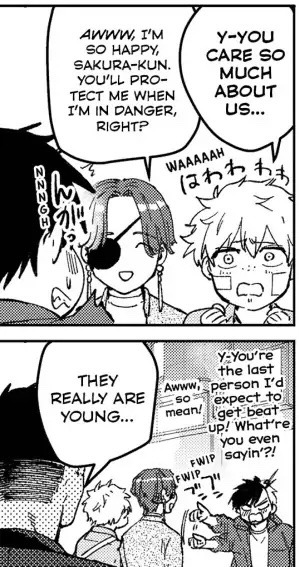
These aren’t even all the instances when Suo does this! I got lazy while compiling images (yes, theres *that* many moments where Suo teases Sakura), but I hope this paints a good perspective.
This makes Sakura thinks of him as “untrustworthy”, in a more lighthearted sense.

Infact, out of anyone else in the cast, Sakura is the only person who actively questions Suo’s character. (I’m not counting Tsugeura because their confrontation was a one time thing)


But here’s the thing: Even if Suo takes advantage of the fact that Sakura is gullible enough to believe anything just so he can mess with him, Sakura still relies on Suo.
He relies on him to come up with a strategic plan for their war, partners with Sugishita despite his initial reluctance, and even follows his advice on how to fight with others people (which works in his favor immensely during the beginning of Noroshi and while he works with Sugishita)

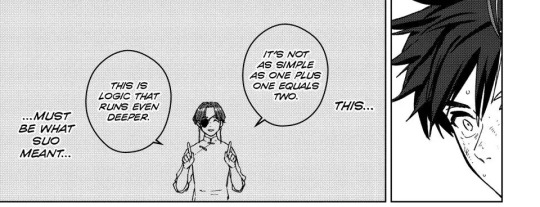

Theres also another moment I’d like to showcase (which is very underrated imo):

Here, we see Sakura taking the support of Suo’s shoulder in order to kick Endo in the face. We also see Suo defending Sakura a few moments ago as well.

Heres’s the thing: Sakura is an arial fighter. He can easily jump to certain heights by himself, much less be able to kick his opponents mid-air. He doesn’t require any support to lift his body upwards.
So why would Sakura do this?

It’s simple: Sakura trusts Suo, whether it be direct or subconsciously. And as his vice captain, Suo also trusts Sakura. Why would he appoint him as class captain if otherwise?

Their mutual trust plays a massive part in their relationship. There are many instances showing this aspect, but for now I will just analyze this iconic scene:

Both Sakura and Suo immediately jump into action in order to protect their friend, Nirei, from any immediate threat (Endo). They exchange no words, only a knowing glance to each other.
I believe that this page shows the essence of their relationship: Despite their petty banter and occasional disagreements, despite how less ‘open’ their relationship is, they are more often on the same wavelength than not.
They care for and trust each other immensely. However, many of their nuances are in hidden between the lines of their relationship due to the guarded nature of characters.
And it is with all these aspects combined that makes the Suo and Sakura duo appealing to many people.
TLDR: Suo and Sakura trust and care for each other a lot, despite their personal shortcomings and Suo incessantly messing with Sakura.
Thanks for coming to my TedTalk. There was so much more I wanted to write about here (such as their flawed perspectives on each other, suo’s perspective on sakura, and how they uplift each other), but unfortunately Tumblr literally refused to upload most of my images and nuked half of this post bc it decided not to save the draft; hence the short analysis. If you have any additional thoughts, feel free to let me know :)
#wind breaker#wbk#wbk spoilers#wind breaker manga#wbk analysis#wb#haruka sakura#hayato suo#sakura haruka#suo hayato
275 notes
·
View notes
Text
all the references in dr. ratio’s character that i could find.
if i missed something, or got something wrong, yell at me in the comments. there are a few other analysis on my page, if you wanna check them out :3 hope u enjoy!!

“ratio” can be traced back to the ancient greek logos. early translators rendered this into Latin as ratio (“reason;” as in the word "rational"). a more modern interpretation of Euclid's meaning is more akin to computation or reckoning.
in Latin, ratio has several meanings, including "reason, ration, calculation," etc
in Roman mythology, Veritas, meaning "truth," is the Goddess of Truth.
there's a lot of owl symbols on ratio, and owls symbolize wisdom, mystery, intelligence and protection.
there's a lot of greek symbolism, esp in his outfit and the way the fabric is tied and the laurel leaves in his hair (in Ancient Rome, it was worn on the head as a symbol of triumph) and the owl motif, the symbol of Athena goddess of wisdom.
dr. ratio's plaster head besides being an obvious reference to ancient greek's herma (symbol of protection, warding off unwanted intrusion or evil spirits), but it is also a reference to, euler, who famously went blind towards the end of his life. his productivity only increased after his blindness, and he was reported to having said, "now I will have fewer distractions," after going blind in both eyes.
dr ratio's eidolons are all based off multiple philosophical concepts and proverbs;
eidolon one: "pride comes before fall" comes from the 'book of proverbs' in the bible.
eidolon two: "the divine is in the detail" explores the relationships in aisha khalid (a visual artist)'s work amongst geometry and precision with respect to the spiritual. the exhibition title is a play on the commonly heard phrase ‘the devil is in the detail’, in other words, the difficulties or problematics of specificity.
eidolon three: "know thyself" is a philosophical maxim which was inscribed upon the Temple of Apollo in the ancient Greek precinct of Delphi. initially, it meant "know your limits," then it was re-interpreted by Plato who understood it to mean "know your soul." then it was re-interpreted again by christian, jewish and muslim scholars used "know thyself" as a command to study the physical properties of the human body.
eidolon four: "ignorance is blight." i couldn't find much for it, but ignorance (lack of knowledge) is blight (a thing that spoils or damages something), which could be the opposite of a quote by poet Thomas Gray "ignorance is bliss."
eidolon five: "sic itur ad astra" literally means 'thus, one goes to the stars'. the phrase is most famously attributed to the Roman poet Virgil in the Aeneid. the phrase can be interpreted as a motivational statement. it suggests that greatness and high achievements are attainable if one follows the right path or method. it also implies that the journey to greatness involves effort and perseverance. it's not just about the destination (the stars) but also about the path one takes to get there.
eidolon six: "vincit omnia veritas" means "truth conquers all things." similar to the Latin phrase "amor vincit omnia," meaning "love conquers all things." this phrase emphasizes the idea that truth is powerful and ultimately prevails over falsehood or deceit.
combat skills:
"mind is might:" the idea behind this phrase is that through the power of the mind, individuals can solve complex problems, innovate, lead effectively, and make decisions that have far-reaching positive impacts. it underscores the value of mental prowess in various aspects of life, from personal development to societal progress.
"intellectual midwifery:" intellectual midwifery is a metaphorical concept that describes the role of a person or a process in helping someone else develop their ideas and thoughts. it's like how a midwife helps in childbirth by supporting and assisting, but instead of a baby, it's about helping ideas or intellectual creations come into being. this can involve guiding someone through the process of thinking critically, asking questions, and providing support so they can articulate and develop their ideas effectively.
"syllogistic paradox" is a situation where a series of logical steps leads to a conclusion that seems contradictory or unexpected. in simple terms, it's like following a set of rules or ideas that seem logical individually, but when put together, they create confusion or a surprising result. these paradoxes often highlight flaws in reasoning or assumptions that we might not initially notice.
"cogito, ergo sum" is a Latin phrase that means "i think, therefore i am." it was famously stated by the philosopher René Descartes. it expresses the idea that the act of thinking proves that a person exists. Descartes used this statement to assert that even if everything else could be doubted or uncertain, the fact that he was thinking was undeniable proof of his own existence as a thinking being.
"mold of idolatry" refers to the different shapes and forms that idol worship or excessive devotion can take. it includes worshiping statues or images as gods, being overly focused on material possessions, or putting anything above the rightful place of worshiping the true divine or ultimate reality. essentially, it describes the various ways people might stray from focusing on what truly matters spiritually.
#honkai star rail#hsr#dr ratio#hsr dr ratio#dr ratio hsr#i love dr ratio#hoyoverse#nerdy stuff grrr#dr ratio x aventurine#dr ratio x reader#ilovedrratio
152 notes
·
View notes
Text
Delusion, Clinical Zoanthropy
I am a clinical zoanthrope. I have schizophrenia. If you have read my posts or blog before this should be no surprise as I am quite open about it. These labels that have been put on me affect nearly every aspect of my life, and greatly affect how I interact with the community. There is often a lot of discussion surrounding ideas of physical identity, delusion and if these things should be acceptable within the community or how to handle these topics.
Length: 3676 words
TW: delusions, reality checking, mentions of medical abuse
The year before last, I had spent quite a bit of time working with another academic to construct a historical materialist analysis of therianthropy. Historical materialism for people who are not familiar is a method of analysing history through the lens of production and class society. In particular, given the apparent wealth of historical therianthropy among “primitive” society, and the narrow niche of modern therianthropy, as well as my own treatment at the hands of the medical system, I wished to understand the origins of the oppression of therianthropic identity. I have to date not completed the project for a number of reasons - limited available literature regarding the transition from pre-class society to slave society particularly regarding religious and spiritual beliefs, personal health and time, and forcing myself to create a complex system of double bookkeeping and analysing my experiences through a materialist lens essentially constantly and forcibly reality checking myself constantly was very taxing.
Although I did not get to the state to write and publish the paper, I did learn a fair bit, and I think the most important concept within this discussion is the concept of delusion and how we define it. There is a common vulgar definition of delusion as believing anything that is not real or not backed by scientific consensus. But then there are many things people believe which is not backed by scientific consensus. While certainly there are people who would say that anyone who believes in ghosts or the Christian God are delusional, nearly half of the people in my country believe in God, however we lack any materialist evidence at this point for such a thing. The state of being identified by others as delusional comes with some pretty serious consequences, it should be noted though that these consequences are not applied to people who believe in God. Similarly, there are times when scientific consensus is simply wrong. Is the man who rejects the inherent inferiority of the [Sub-saharan Afrikan] race because of their skull shape and “thick skin” delusional? We today would collectively say no. For a man in the early 19th century, this would have been scientific consensus even if now we should find such a thought abhorrent. Was he then delusional? (Though some people did try to justify slaves escaping as a mental health condition Drapetomania, and historical terms like madness are often connected to modern terms like delusion and psychosis). I think often modern humans can create an almost religion out of science and progress and belief in their own rationalism - that not only is there absolute objective truth, but they can and do know it all in this particular moment, and that the society they exist within does not effect an impact on their view.
It is important to understand that delusion has a fairly specific definition and caveat when talking in a medical definition. That important caveat is that the belief conflicts, or is not standard, within their culture or subculture. Not only that, the belief must be very fixed and firmly set which does not respond/change to the presence of outside evidence. This cultural context is an important factor in the diagnostic criteria for delusions, as well as dissociative disorders like OSDD and DID (it may well be important for other conditions diagnostic criteria as well though I lack experience to speak on that topic).
Delusions -are- very much socially defined. I make the joke often that a rich man hears the voice of God he runs for office, I hear the voice of a spirit and need to be on antipsychotics. There are a number of examples namely in SEA where the experience of transforming into another animal would be considered entirely within the range of normal possibility (though notably with tigers primarily). There are also cultures and practices in which physical transformation is not considered delusion but a normal part of ritual notably among the Xan peoples. Among some Siberian cultures as part of hunting some will take essentially the mind of a wolf. In South Asia there are also recorded practices in which a person’s soul is bonded to and moved to an animal’s body in the night. Most people those reading this might encounter day to day would think these are surely delusions, but for those people, it is just a normal part of life and culture.
Most people here would collectively agree that therianthropy is not a delusion, however from outside the community many easily could argue it. You -are- human, you can look at your body and it and see that it -is- human. If you argue for past lives, there exists no evidence supporting that and no evidence supporting the existence of spirit or plausible explanation beyond hallucination despite many attempts to measure their existence. Nor do you have the instincts of that animal because you are clearly a human, and any "instincts" you might have are phantoms of the mind or attaching to a certain animal as a way to manage your life. However neither of these explanations would be acceptable nor would they convince you that you are wholly and entirely human.
Similarly with transgender identity, people here would collectively agree that is not a delusion. But 60 years ago? Or among transphobes? You are experiencing a delusion. You are obviously a wo/man, and no amount of hormones, [presentation], or [surgery] will change that. We would all collectively say fuck that shit, but you know who agrees under certain circumstances? WPATH in their Standards of Care directly notes among certain conditions of transgender identity as delusion (or at least in their old SOC before informed consent became common). It is common for people with schizo-spectrum disorders and higher level structural dissociative disorders to be denied care, or to face significant pushback. But this can also be true for all sorts of other “less serious” conditions such as austime, adhd, depression etc. This is something I have faced, and who knows how many others have faced it as well.
But what a delusion is very much defined by perspective and culture. It is easy when sitting on the "non-delusional" side of a cultural belief, to believe the order of things is logical. However, when I must construct materialist explanations of experiences, a task for which I am forced as part of double bookkeeping, the differences between my "delusional" experiences, and others "nondelusional" experiences especially in regards to therianthropy is one of degree, not of kind. Do not make the mistake to think that in other scenarios, other cultures, your experiences may be seen as delusions, and in other places, mine as natural and grounded in reality.
My experience as a clinical zoanthrope has left me often feeling quite divorced from the community, that I am separate, unwelcome, or an interloper in what is supposed to be my own community. I have been in the community for a while, but only at certain points felt comfortable to really call myself therian, a feeling which is again waning. There is a strong push constantly against physical identity. Even the most (in)famous phrase in wider culture about therians is the “on all levels except physical I am a wolf”. However this pushback against physical identities, especially from the concerns over P-shifter cults and abuses, created an environment that for me to be tolerated, I would have to constantly “show insight” or really reality check myself, and ensure all the others there knew that I knew my experience was not real and was not like their experiences were (that theirs were real and different). I still often have to do the dance describing my experiences, and even in the terms I use for myself as a clinical zoanthrope is indirectly that same dance.
The therian community often prides itself on how accepting it is. Though to be honest, I really have to question if this is the case. I have always felt unwelcome by the broader community. But so have very many others. It always strikes me that whenever I really share my experiences, how many others really relate to that feeling of not feeling wholly secure or belonging within the community. My orca friend, Ike, has talked quite a lot how they simply did not join the community for so long for feeling unwelcome. Sharing my experiences on a discord server a few weeks ago I learned another member was also a zoanthrope but had never shared it for fear of ostracization. A number of others expressed sentiments of feeling not total included, some for shift strengths, some for things like sexuality, theriomythics often get excluded, etc. Heck, by some accounts even the transition to the term Therian away from Were was an effort to include more people besides just shapeshifters.
Really when you think about it, it is not surprising so many people feel excluded in various ways. Therians have all these lines that you have to sit inside of and not cross to be acceptable to the community. But when you try to actually measure those lines many are not only extremely blurry, but vary person to person. Indeed my own experience is that there are people that do accept me, even if the wider community does not, and that is really the only reason I stayed.
The community has historically for instance a pretty hard stance on delusion and hallucination. The question though is, when does a shift move from being a socially acceptable phantom shift, to an unacceptable hallucination. For me in particular, my sensation of shift goes through a fairly long process of getting more and more intense, but it is also really a quite smooth process. It is like following a colour line, when does ‘blue’ truly begin? The first sensation is often a slight tickling, and very light phantom touch that you can sort of see through the feeling on your body. Beyond that the sensation gets more intense and becomes bothered from having things push against or intersect it. Further it begins to have not only form but colour and texture, but still if I look at the limb I cannot see it, I still see a human limb, though I do not expect it. Further the visual appearance comes in more and more until eventually my human parts are gone, transformed into animal parts I can see and I can touch. When we write it out like this it is pretty separately defined, but in the process this occurs for me, it is very smooth.
After enough quantitative change, there is a qualitative change, but where and when that occurs is hard to say. I think the first two experiences are very common among therians. I think the third experience is also fairly common but that starts to get more and more into the blurry lines, and if you cannot see where that line is you are likely to downplay your own experiences for fear if you say too much, you will be excised or ostracised from the community. But this fear also has the doubly cruel aspect that you can never really know where that line is because many people downplay their experiences to make them palatable, and so though many others might share in these experiences, people simply do not speak of them because they only see either extreme being shared, the particularly minor shifts being accepted, or the extreme shifts being sorted into delusions. I think it creates a false binary from a spectrum of experiences.
So many of these blurry lines exist though. What age can you be taken seriously? What platform do you use? How many kintypes is too many? Theriotypes being too common? Theriotypes being too rare? Are paleotherians acceptable? Are theriomythics acceptable? Can a dragon be a therian? Can an otherlinker or copinglinker have their identity so long it becomes therian? Are beastly animals from fictional settings acceptable or should they be with fictionkind? What sort of sexual and romantic expression is allowable? Is transspecies an acceptable identity? Some of these are blurry, some of them are clear, but they all wiggle around in different ways of some people will find them acceptable and some not. This leads to people self-censoring to the safe answers that they know are acceptable and prevents them really exploring their own identities, but also these questions within the community as it learns and grows and becomes more inclusive. In a certain irony, therianthropes as a community, are actually quite demanding in their conformity while preaching of their acceptance.
There has been a significant push in recent years to give greater levels of inclusion to therians with both delusional identities and physical identities. People are generally more accepting of zoanthropes and at points I have felt comfortable even to call myself therian and not just a member of the community. But there are also a number of additional terms, namely endel and holothere, which cover these experiences. However, something I note often when people talk why I as a clinical zoanthrope can be acceptable, while P-shifters and at times holotheres cannot, still comes down to that I acknowledge my experience as delusion. When I read the experiences of at least some p-shifters and holotheres, often the difference really is not so great, I often see their experiences mimicking or mirroring my own. I do use the word clinical zoanthropy, which on some level does indicate an understanding I know that at least others see my experiences as not real. This is a pretty common feeling among zoanthropes, we use this word, we know the humans think our experiences are not real, but they are incredibly real to us.
The question then is what should be done with us? There is a lot of comment that allowing us in the community to share our experiences or not reality checking people is encouraging delusion. People also say that delusions are harmful and that we should seek medical help. There are quite a few people who even wish to excise or isolate those who are anti-psychiatry and anti-recovery from the community.
If I am forced to analyse my experiences through a materialist and distant lens, it is quite clear my experiences are heavily rooted in delusion. I am a scientist, and there is no means under current knowledge to explain what I experience except hallucination - still I believe it fully. My knowing this is the only logical explanation does not lead me to believe it, to truly believe it inside. I mentioned before I had to give up on projects I did really enjoy because forcing myself to continuously deny my experiences and continuously reality check myself, brought to me very much distress. There are times I have wanted to be reality checked, but for vast part that is the remainder it is really distressing. It is distressing to be told a core part of your identity is not real, to be told the you that exists isn’t the real you, and sometimes see people mourning the “sane you”. Individuals in the community are not going to solve my “delusion” by reality checking myself or others.
Nor will them blocking me from the community or ensuring I do the dance for them encourage my “delusions” away. Delusions are heavily fixed experiences, and though you can encourage them in certain ways (think the example of people making “in your walls” jokes at schizophrenics), us talking about and sharing our experiences with each other and in our own community helps us feel understood and a sense of belonging. There are so few of us to start with, and the community closest to us either often disallows us, or makes us sit at the edge never really able to join. All banning us does is further isolate us, and for many delusions reinforces that we will never be acceptable or tolerable to others and it is best we are alone so we don’t hurt others with our presence.
I cannot speak on every person’s delusions, but I can speak on my own. For the question of if delusions are harmful, I think it often asks the wrong question. Who is it harmful to? Under what framework? Who thinks it is harmful? What does the patient want? I think one could say that my delusions of turning into a whale do harm me. I have trouble to interact with humans, I cannot work a full time job, I struggle in relationships, many nights I lay on the couch stuck for hours simply unable to move. These are all pretty negative things no? But it fails to ask why are these things harmful? A doctor looks through a very human framework and sees that I cannot do the human things and sees that I must have a poor quality of life and these delusions need to be addressed. But I am a whale and it is a core part of me, these things can be distressing, but whales cannot interact with humans the same way two humans would, work a full time job, have relationships with humans, and if you stuck them on a couch they would also not be able to move. This all is distressing and perhaps harmful, but then what other option is there? What the humans offer to me as solution is far worse.
I am anti-recovery, at least for myself. I think it is important to ask what does recovery look like? For me recovery would be to return to the water where I belong. But the humans would certainly say otherwise. For them recovery would look like fitting into and functioning within human society - having a job, a house, a car, a husband, kids, going on holiday, etc. I am not a human and I do not wish to be a human and live among them. However what is worse is how the humans would go about fixing that. I have been locked in hospitals, I have been strapped down, I have been sedated, I have been put on horrible meds that destroyed things I cared about and have often left me a shell of a person (there is a reason they were marketed as a chemical lobotomy). Some things I have gotten better in over time, and I can hold a job for the moment, even quite technical and difficult jobs.
However, the damage done to me from the humans was severe. Although I can talk about being a whale as delusion, the why is really far more impactful and distressing in my life. I was taken from the water, turned human, and am a useful thing for the humans. This understanding of myself as merely a tool and something the humans can do whatever they want with me is the real distressing aspect of my life. For me, the ‘help’ I received at the hospital only strengthened and set this delusion in so much firmer. I can look back at certain experiences, I can see the humans don’t have the technology to do what they did to me, but then I also have those years in the hospital, those years where everything was very apparent and clear and something that others can confirm and it seems to only further make plausible the experiences of the past, and those in the present the fear for what the humans will do to me. I know that I am deteriorating, I am struggling more and more, but nothing the humans offer me will make things better, they will only hurt me more, and if I ask for help, and reject it, they will only see it as proof I need the help more and force it onto me, which will only further reinforce that delusion.
If someone wishes to see a doctor and talk about therian things, I do often warn them of caution for what happened to myself and I do not want others hurt that way. I also urge them to think about what they want as the outcome from that discussion or what they hope will happen. A lot of mentally ill people have been hurt by doctors who thought they knew best, and once something is said, it cannot be undone. However, in the end they are free to decide what they will, and are free to navigate the medical system if they think it will benefit them.
For myself, I struggle to believe that doctors would really help me and instead work to help myself and my cetacean friends so that maybe someday we could swim again and swim forever. That we can fix ourselves and heal. That in time the deep scars across our bodies might start to fade and look like the scars of other captive cetaceans. That instead of surviving merely trying to please the humans to not be hurt, that we might actually -live- and have the life we were denied.
We are still people with agency, agency to choose our own path, to choose what brings us joy, to decide what we want from life, and from our healthcare. Or at least we should be granted that agency. We should not be excluded from the community or forced to dance around our experiences as not real for the comfort of others who happen to lie on the other side of the sane-delusional line, afterall the positioning of that line is very arbitrary and could easily swing to find yourself on my side of that line.
~ Kala
#therian#therian discourse#clinical zoanthropy#clinical lycanthropy#clcz#therianthropy#actually schizophrenic#physical nonhuman#physical therian#reality checking#tw reality checking#tw delusions#tw mentions of abuse#kala discussion
251 notes
·
View notes
Text
"this was actually racism it just produces an identical result in parallel to transmisogyny because racists also dont think nonwhite womrn are real women" type posts fundamentally misunderstanding oppression schematics once again. you cannot separate white supremacy, transmisogyny, and intersexism; gender and sex are tools used to enforce white supremacist constructs of the "correct" human body. in describing a situation where an intersex woman of color is dehumanized via misgendering and transmisogynistic gendered violence, "racism," "transmisogyny," and "intersexism" are all different words describing a single manifestation of oppressive forces that categorize her body as fundamentally "incorrect."
there is, fundamentally, no way to extricate gendered racism from intersexism from transmisogyny; these are all different lenses through which to rhetorically categorize the forces dividing human bodies into "male" and "female" as laid out in white colonial structures. if one is mostly discussing this impact on black americans, it follows naturally to use the lens of white supremacy and discuss the racialized aspects of this. if one is mostly discussing its impact on trans women, it makes sense to take a transfeminist lens; if discussing its impact on the intersex population, it follows to use the lens of intersexism. if the situation described is impacting all demographics, it makes sense to use all three lenses, and even to double-stack your lenses and approach the matter with even more granular terminology and analysis approaching the intersection of these as one coherent demographic being acted on in unique ways (this is the origin of the term transmisogynoir, as i understand it).
the distinction in approach is subtle but important, particularly as "it's just racism" takes are being used to outright quash discussion through the intersexism lens.
548 notes
·
View notes